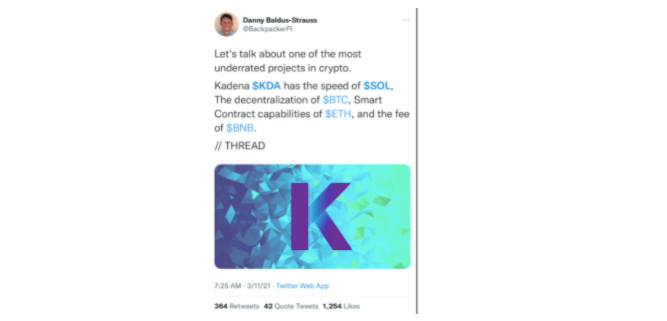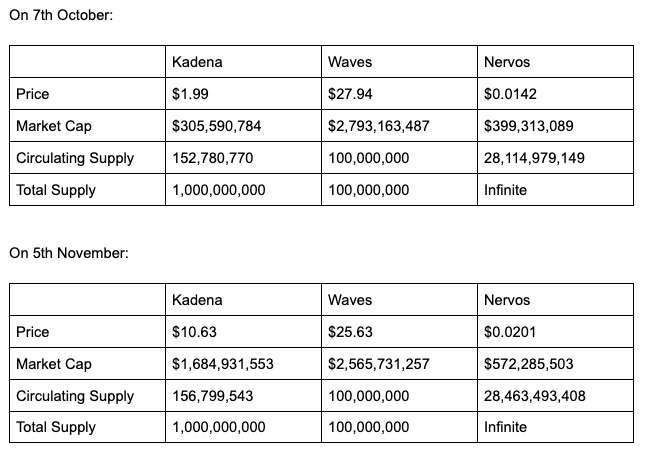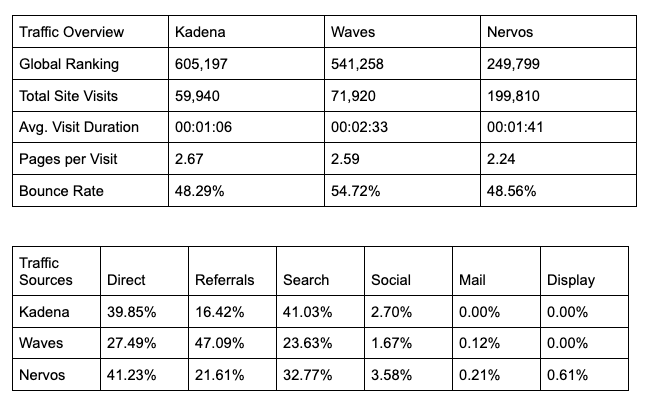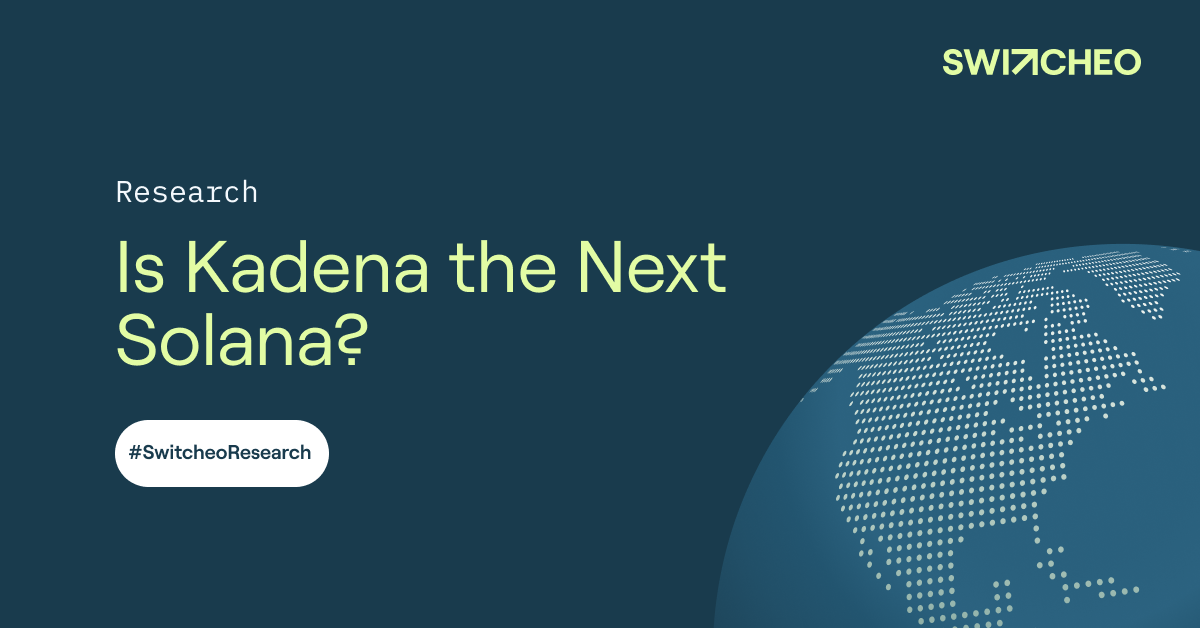Kadena is an interoperable Proof of Work (PoW) hybrid public and private blockchain that runs ChainWeb, a protocol that delivers security and high-transaction throughput at the base level. The network aims to become the world's first true scalable blockchain and to feature a new smart contract language that’s built from scratch, named “Pact”, which comes equipped with formal verification and upgradeable smart contracts.
Context
Traditional PoW as demonstrated in the Bitcoin network showed how decentralized networks can work and accrue value for users and network stakeholders by solving key problems and creating trustless public networks. However, PoW has faced several criticisms in recent years, which includes performance issues and inefficiencies: slowness, consumption of large amounts of energy, congestion pricing in the form of high transaction fees and their very low throughput.
Although attempts to change such limitations through protocol modifications have been made, none have provided a practical path to approach the throughput levels of modern fiat-currency payment networks. Furthermore, newer consensus models like the Proof-of-Stake (PoS) that promise greater efficiency and effectiveness have emerged, visibly replacing PoW as the choice for decentralized consensus.
There is a growing list of issues that suggest that PoW networks are not viable in the long-term in terms of health and maturity. While these networks have served a key role as a proof-of-concept, they are strictly inferior to newer systems across all important aspects — security, cost, efficiency, performance. Therefore, there presents a need to resolve these current limitations of PoW in order to prove its viability in the long run.
Introduction
A solution to the current limitations of PoW, Kadena seeks to create a scalable and developer-friendly public blockchain that offers a level of security similar to Bitcoin. To achieve this, the network presents a novel proof-of-work model called Chainweb, and a new smart contract language, named Pact.
ChainWeb is a parallel chain PoW architecture that merges hundreds or thousands of individually mined peer chains into a single network. They have the potential to achieve throughput in excess of 10,000 transactions per second. On top of that, Chainweb also provides a notable increase in security, greatly reducing confirmation depth.
Their native smart contract language, Pact, is configured to work on common flaws identified in Ethereum's Solidity, in particular its susceptibility to unbounded loops and lack of Formal Verification. The Pact smart contracts can also be upgraded at any time without requiring a hard fork.
Ultimately, Kadena aims to optimize their base layer for transaction throughput and developer adoption without the use of any second layer scalability or functionality solutions that tend to complicate application development.
Kadena has also developed a private blockchain, now called Kadena Kuro (formerly ScalableBFT), that predates its public smart contract platform. It utilizes a Byzantine Fault Tolerant (BFT) consensus mechanism and is optimized for enterprise-grade use cases. Since 2018, the private blockchain has been used by a healthcare consortium to reduce the effort needed to collect and maintain insurance provider information. Kadena Kuro can also be treated as a side-chain with a public blockchain network (e.g. Kadena's public platform) to speed up transaction processes and create new marketplaces for data.
Product Analysis
Being the only scalable layer-1 PoW blockchain available currently, Kadena has hundreds of node operators across the world securing the network now.
In less than a month, the price of Kadena increased by more than 5x from less than $2 to more than $11.
Technology
Kadena aims to be a single source for the resources needed to build blockchain applications, consisting of a public chain protocol called ChainWeb and a private chain protocol called Kuro. The public and private networks are interoperable through the smart contract language Pact.
With just 20 chains, the chain has achieved an outstanding 480,000 transactions per second. The next major upgrade will be 50 braided chains working in parallel and it is expected that the throughput will exceed 1 million transactions per second.
Using graph theory, Kadena is able to make the PoW blockchain highly scalable. They currently utilize a 20-chain graph, whereby it only takes 3 hops to get from node to node. This means that we will only have to wait 3 blocks (30 seconds per block) after a transaction before the entire network’s hash power is protecting it.
A more detailed explanation can be found here: https://medium.com/kadena-io/how-to-scale-a-proof-of-work-blockchain-9233e5b4b62
Chainweb
A public blockchain protocol of Kadena, Chainweb is a braided, parallelized proof-of-work consensus mechanism that improves throughput and scalability while maintaining the security and integrity found in Bitcoin. Unlike existing PoW architectures, Chainweb provides massive throughput without significantly increasing hash power.
The architecture of Chainweb started from the idea of integrating Bitcoin's Simple Payment.
Verification capability (SPV) into Kadena’s smart contracts. The SPV, also known as light client support, enables participants to verify a particular transaction by querying the blockchain for a Merkle proof, without the need to process the entire blockchain.
For ChainWeb, the braided chains combine Merkle proofs from neighbouring chains in a fixed graph layout that makes sure that proofs quickly spread to every other chain in the system within some maximum block depth. With every new chain, throughput increases linearly. To replace a given block, an attacker must fork every chain in the network, or, in other words, attain the cumulative hash power of every running chain.
Chains in ChainWeb can be specialized to cater for specific operations, such as supporting file storage applications. Developers can fulfill their throughput requirements by selecting the chains to run their smart contracts. Most importantly, Kadena’s PoW blockchain does not increase energy consumption as it scales thanks to the ChainWeb protocol. This is evident from the expansion from 10 to 20 chains, Kadena still consumes the same amount of energy after the expansion.
All in all, these innovations of unmatched speed, throughput, security, and specialization can sustain unexpected spikes in demand, enhance operational efficiency, and allow for a completely new class of business applications.
Video of how ChainWeb works: https://youtu.be/hYvXxFbsN6I
Pact
Pact is a new programming language for writing smart contracts to be executed by Kadena, with the aim to empower developers to execute robust, performant transactional logic, carrying out mission-critical business operations quickly and safely.
They key features of Pact includes:
- Turing-incomplete safety-oriented design
- Human-readable, on-ledger code
- Atomic execution (transactions)
- Module definition and import
- Unique “key-row” + columnar database metaphor
- Expressive syntax and function definition
- Type inference
- “Module-guarded” tables
- Single-sig and multi-sig public-key authorization
- Multi-step “pacts” for confidential execution
- Key rotation support
- Designed for direct integration with industrial databases
A potential spiritual successor of Bitcoin, this smart contract language is essentially the solution to all of DeFi’s hacks and exploits.
Kuro
Kuro, Kadena’s private blockchain, is a distributed ledger where only invited users can join and access the ledger data within the network. Both private and public blockchains offer a means of recording and replicating an immutable, cryptographically secure ledger. On private blockchains, this is done through consensus mechanisms like voting while on public blockchains, this is done through various consensus mechanisms including mining.
Kuro has proven to support up to 8,000 transactions per second across 500 nodes, and is available for trial on AWS and Azure as an open-sourced project. By making Kuro open-sourced and using Pact, Kadena is making its permissioned blockchain as accessible as possible to the hands of developers looking to create dApps.
Network Participants
- Participating Nodes
- Miners
- Developers
- Investors
Products
Kadenaswap (Backend)
Kadenaswap is a DEX running on the Kadena blockchain, modelled after Uniswap and other “constant product” exchanges. It operates as the backend, managed by the Kadena team themselves.
Kadenaswap essentially provides liquidity for pairs of tokens, so that users may swap one token for another at the ratio currently provided by the pair. Kedenaswap will tap on the chain’s multi-chain scalability and existing public blockchain and leverage on the Pact smart contract language to interoperate with major DeFi protocols.
Kaddex (Frontend)
Kaddex is a multiprotocol DEX powered by Kadena, providing users the key to earning passive income with zero gas fees. It operates as the frontend of Kadenaswap, but is managed by another team and not the Kadena team. Kaddex will not only run in the Kadena network, but Cosmos and Polkadot as well.
On Kaddex, users can swap tokens and participate in Liquidity Pools. Liquidity Providers (LPs) will not be required to hold 2 currencies to become an LP. As an added incentive, early LPs will be rewarded with additional pooling rewards at approximately 1% on all swaps (0.25% from fees charged to swappers, and the rest subsidized by Kaddex).
Currently, there is only one pool available for LPs, which is the KDA/FLUX pool. Flux is a web 3.0 decentralized computing network used for purchasing resources, collateralizing nodes and fueling transactions on their product FluxOS. With Flux, users can simply develop, manage and spawn their applications on multiple servers at once. Leveraging the power of multiple blockchains, Flux have successfully partnered with Kadena, the only scalable PoW blockchain.
Kadena Chain Relay
The Kadena Chain Relay will offer the first step to a robust economic security through bonded KDA for their Ethereum, Celo and Terra decentralized bridges. To accept and validate block headers from other blockchain platforms like Ethereum, Celo or Terra, the Kadena bridge needs a way to accumulate assurance around the headers.
To do this, the smart contract relies on the Chain Relay to validate that the block header referenced in the supplied proof exists on the other blockchain platform. Thus, the Chain Relay provides a critical service as an attesting authority for block headers from the bridged chain. In the future, the Relay will open up for the usage of other non-KDA tokens for bonding, not excluding the possibility of a governance token as well.
Read more: https://medium.com/kadena-io/announcing-the-kadena-chain-relay-a801a2756036
Kadena NFT
Kadena is bringing forward the next generation of NFTs, introducing features such as on-chain minting, custom marketplaces and many more. With their Pact language, interoperability is possible by making it safe to call other contracts. This also means that a single poly-fungible Kadena NFT ledger can service the entire market. They have also formed strategic partnerships with several NFT projects such as the NFT game called UFO Gaming. They will be building their P2E NFT game on Kadena, which combines metaverse, virtual land, NFT, gaming and IDO all in one place.
NFTs on Kadena are unique for the following reasons:
- Pact does not have EVM safety issues.
- Pact has too flexible of a custody model to handle automatic associations.
- A module can be upgraded to manage custody of a module-guard-controlled account in some token.
- Poly-Fungible standard: fractional NFTs with cross-chain and multi-sig safety. Fractional NFTs are tokens themselves.
- Cross-chain NFTs, effortless inventory management.
Essentially, owners of a Kadena NFT are entitled to the following:
- Easily prove that you own the NFT, with multiple wallets, from multiple devices, and no one can manipulate it in any way.
- Sell all or part of the NFT, and in some cases, this will earn the original creator resale royalties.
- Eligible to hold the entire or fractional NFT forever and securely.
More on: https://kadenacommunity.medium.com/kadena-nfts-the-future-is-poly-fungible-6fa14c40e879
All these features of the Kadena NFTs seek to rectify the current flaws of NFT marketplaces. For instance, we can see from the recent twitter post below, one of the user’s NFT was removed without any warning or explanation.
This is just one of the problems with existing NFT marketplaces. Kadena NFT is doing exactly the things to stop this, by making NFTs truly exchange-independent. This is fulfilled through adhering to a standard that can specify not just royalties but minting, burning, sale, transfer.
With the NFT market exploding in popularity this year, Kadena NFT is one to watch. They are set to transform the industry, firstly with the Poly-Fungible standard: fractional NFTs with cross-chain and multi-sig. In the future, users will be able to mint marketplaces and not just tokens. They are maximizing profits for creators with innovative standards and free or negligible gas for the minting and transfer of NFTs and we can expect something big to be coming very soon on their platform.
Tokenomics
Token Utility
$KDA serves as the native token of the Kadena blockchain. It is used to pay for computing power on the blockchain (i.e. executing smart contracts and transactions), equivalent to the function of gas on Ethereum. It is also used to reward miners for discovering the next valid block.
To sum up, the use cases for $KDA is as follow:
- Direct payment transfers between participants
- Creating new smart contracts
- Gas cost for executing smart contracts
Token Supply
Total supply: 990M (after accounting for 10M burned at launch).
- Mining share: 700M (emitted through mining over 100+ years).
- Platform share: 200M (3.7M was already released on Jan 1 2021, the remaining emissions are for 196.3M KDA over 9 years).
- Investor, strategic, and contributor: 90M.
- Burned at Launch: 10M.
Token Inflation
As of January 2021, there have been changes to the platform emission rate. Just like protocols like Bitcoin and Ethereum, Kadena will be decreasing mining emission rates over time in recognition for its beneficial effects.
The emission timeline will be extended by 5 years such that emission completes by 2030, ten years after the network launch.
To visualize this change, we look at the impact on overall inflation for the upcoming year (Jan 18 2021 — Jan 18 2022, Old and New):
- Mining emission rate: 23% (unchanged)
- Total emissions (mining + platform) with “old” genesis rate: 72%
- Total emissions (mining + platform) with reduced platform rate: 46%
These numbers are based on the total coins in circulation reported in the Kadena Block Explorer on Jan 25 2021 of 98.8M circulating coins, and a mining emission of 22.9M coins in the time period Jan 18 2021 — Jan 18 2022. The platform emission decreases from 48M tokens/year to 22.08M tokens/year.
Source: https://medium.com/kadena-io/update-to-the-kadena-token-economic-model-21e1ec18f099
Roadmap
Key Completions:
✅ Supporting Ethereum bridge proofs in Chainweb 2.4
✅ Launching Kadenaswap “Bountyswap” on mainnet
✅ Modifying the platform emissions structure
✅ Community ambassador program
✅ Partnering with Tokensoft to bring wrapped assets onto Kadena
✅ Major exchange listing
✅ Production Chain Relay
✅ Launch DAO Foundation for economic development
✅ Pact 4.1 Release
✅ Chain Relay Software on Testnet
✅ Wrapped Bitcoin on Kadena
Upcoming:
🔜 Wrapped KDA on Ethereum - in progress
🔜 Web Extension Wallet - in progress
🔜 New NFT projects - in progress
🔜 Ethereum bridge launch - in progress
🔜 New developer grant projects - ongoing
🔜 Lending platform infrastructure - design phase
🔜 Testnet bridge to Terra - design complete
🔜 Kadena fiat on-ramp integration - partner identified
🔜 Wrapped ETH on Kadena - Q4 2021
🔜 Kadena sustainable mining initiative - Q4 2021
🔜 Ledger wallet support - Q4 2021
🔜 Chainweaver web - Q4 2021
🔜 Testnet bridge to Celo
More on: https://www.kadena.io/roadmap
Fundamental Analysis
Macro Analysis
While the move from PoW to PoS is understandable given all the PoW challenges that PoS solves, there are still several concerns about the PoS consensus raised.
For instance, some are worried that PoS networks are facing difficulty in securely functioning as a settlement network because malicious attacks are prominent without significant costs.
Furthermore, as more cryptocurrencies transfer their network to PoS validation systems, a growing number of users will take part in validations and earn staking rewards. As a result, PoS has been associated with significant implications regarding taxation, where validators are being overtaxed relative to their actual economic gain. In Germany, PoW assets can be spared from taxes after a year but PoS assets must be taxed for 10 years. Although concerns have been raised in a letter by some members of the Congress to the IRS, this still remains as a problem to PoS validators.
Kadena vs Solana

Many in the crypto space have associated Kadena with having the speed of Solana and it could do a bull run similar to Solana. This could be attributed to the low fees, high tps and low block time promised by Kadena, that is comparable or even better than that of Solana.
*Market cap of Kadena has increased significantly since the publication of this chart.
Solana and Kadena have been in the crypto space for around the same duration but Kadena seems to be playing the long game by focusing on their real technological edge as opposed to placing themselves in the middle of an extremely competitive market.
While Kadena still lacks an ecosystem like Solana, they could potentially skyrocket once developers start to build on them and once they prove what they can do.
Competitor Analysis
The key competitors of Kadena include Waves and Nervos.
Waves is an open PoS blockchain protocol and development toolset for Web 3.0 applications and decentralized solutions, aiming to raise security, reliability and speed. It allows any participant to develop their dApps, fostering mass adoption of blockchain. Although Waves is a PoS blockchain, they are working on a solution called “Gravity Hub”, which could allow their private and public blockchain platforms to become interoperable in a similar way to Kadena’s hybrid chain. This makes Waves a significant competitor to Kadena.
Waves’ roadmap:
Nervos network is an open-source PoW public blockchain ecosystem and collection of protocols creating the foundation for a universal internet-like public network. They have built a suite of integrated solutions which they have called the Universal Passport. This is their solution to creating a next generation of interoperability that will empower the creation of Universal dApps.
Nervos’ roadmap:
Key Market Stats

Opportunity
PoW consensus remains as the only “battle-tested” consensus protocol primitive as of now, since other systems like PoS are still in the experimental phase. Furthermore, most regulators still do not see PoW miners as money transmitters, as backed by the statement made by the SEC regarding Bitcoin not being a security. This makes the PoW system way safer than other systems from a regulatory perspective.
As opposed to PoS tokens, the security of the Kadena network is entirely independent of Kadenaswap or other on-chain uses for $KDA. Under PoS, on-chain DEXes will compete in terms of staking a source of income if one provides higher rewards for staking the token. This poses a security and liquidity problem for the chain. However, Kadena will not face such an issue since $KDA is independent from any application on the platform.
In terms of transaction fees, since Kadena can scale the number of chains to meet any demand, this makes gas fees on the chain microscopic. Hence, dApps on the chain can simply scale out to the number of chains required to service demand.
Kadena stands out among their competitors in that they are a one-layer network, whereas the other competitors employ a two-layer approach. They also claim to have fixed the onboarding issues that have plagued blockchain networks and they have been working with enterprises which includes the US based USCF, an alternative investment product provider.
Bitcoin and Ethereum are still in the lead and Kadena will have to challenge these leading networks to prove their value.
Community
Twitter - 50,100 followers
Discord - 11,245 members
Telegram - 9,574 members
YouTube - 2,070 subscribers
We can see that the Kadena community base is doing relatively well. In less than a month, their community following doubled. However, to stand out among their strong competitors, blockchain community support is extremely important. This is something that Kadena can work on.
Traffic:

Team
Kadena was founded by Stuart Popejoy and Will Martino.
Stuart Popejoy previously directed JP Morgan’s Emerging Tech Blockchain group and has 15 years experience building trading systems and exchange backbones for the financial industry.
Will Martino was the lead engineer for Juno, JP Morgan’s blockchain prototype. He was also the tech lead for the SEC’s Cryptocurrency Steering Committee and the Quantitative Analytics Unit.

More about the Kadena team here: https://www.kadena.io/team
Technical Analysis
Looking at fib extensions, starting from the low in August to the high in September, a likely profit taking area would be between 1.0 to 1.618 if the sentiments are bullish, which will put the market cap between $1.6b to $6b. As of this writing, it has hit the first profit taking area at 1.0, around $10.
However in terms of the mayer multiplier band, the price is relatively overextended right now. This does not mean that $KDA can’t keep going up, it’s just an indication that the price has deviated far from the moving average, but a reversion to the mean might not be necessary if there are continuous catalysts such as a new trend or narrative or fundamental reasons, as stated above.
In terms of weekly RSI, it’s currently sitting above 90 which is very high. However this does not mean that the price will definitely go down as a bearish divergence could occur as well where the price goes higher while the RSI goes down, especially if FOMO, narrative, and speculation comes into the picture.
Note: This research started in September when $KDA was less than $2, which was considered potentially undervalued to us, hence our interest in writing the article. However we got busy with other stuff and now as we are finally ready to publish the article, the price is already above $10 and has already hit our expectations. Hence, please understand the risk if you’re keen on buying in at this price, as this article is not financial advice.
Risks
The volatility associated with gas prices ought to be addressed as it presents a potential risk. In response to this, Kadena plans to offer products (swaps, etc.) for businesses to hedge their risk. A significant amount of $KDA will be required to sustainably capitalize the providers.
Conclusion
All in all, Kadena is trying to solve some of the industry’s greatest challenges by bringing us a hybrid blockchain that is scalable, customizable and secure. With a strong team, there is no other chain out there doing what Kadena is doing. Q4 of 2021 is going to be huge for them, with big things coming up in their roadmap.
With only 20 chains now, Kadena has already achieved an industry-leading 480,000 transactions per second, which is higher than Solana’s TPS. With future upgrades, the prospects for them are endless. $KDA still seems undervalued for now and there is a lot to anticipate from the chain.


